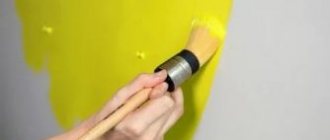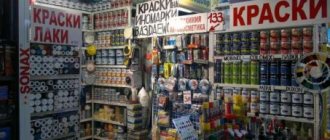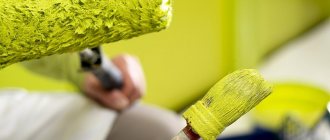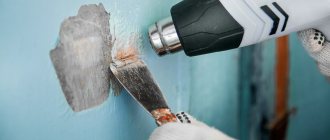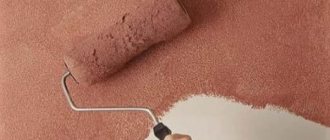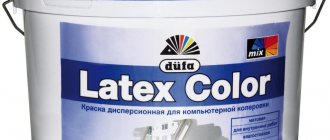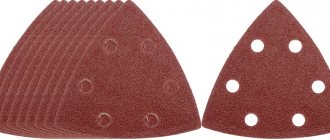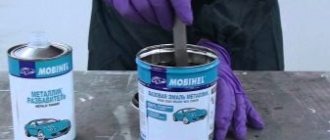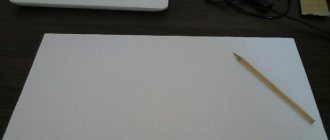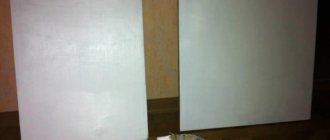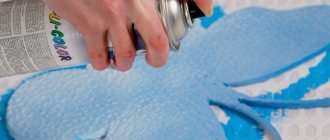Good afternoon, dear readers of our blog. Recently my daughter faced a serious problem. She loves to draw and asked me to buy her a painting with numbers. I drew these with felt-tip pens as a child, but the popularity of these drawings has revived again quite recently. We purchased several of these pictures and paints for them. My daughter drew with enthusiasm, and after finishing several images, she gave up on it. However, after some time, the child decided to paint again, but we were faced with the fact that we did not know how to dilute the paint for paintings by numbers. It turns out that they managed to dry out, leaving us no chance. Today we will analyze solutions that we have personally tried and found bit by bit on the Internet.
How and with what to dilute dried acrylic paint
Sometimes damage to acrylic paint cannot be avoided.
Sometimes the jar fails, and sometimes there is too much material left on the palette. In any case, I don’t want to throw it away at all. Acrylic paint has dried out, how to dilute it if it has acquired a “rubbery” consistency? In this case, you can simply add a little water to it. However, if the acrylic paint for painting has completely dried out, drastic measures will be required. There are a couple of ways to bring material back to life.
Several options for what you can do if acrylic paint has dried:
- The easiest way is to dilute it with a special product. So, if acrylic paint is dry, how to dilute it? For these purposes, a special acrylic thinner “Gamma” is suitable, which can be purchased at art stores. White spirit, an industrial composition for removing old paintwork for all types of paint, or solvent will also be effective. When diluting with special means, it is worth considering that they may not help if the acrylic paint has dried completely.
- There is a more radical way. A solid piece of acrylic must be ground into powder. It should be as small as possible. Then the powder must be heated in a water bath or diluted with boiling water.
- If hot water doesn't help, you can add alcohol or regular nail polish in small amounts.
Paint deteriorates irrevocably only when exposed to very low temperatures due to the polymerization of the acrylic emulsion in the composition.
However, despite the fact that in some cases acrylic can be reanimated relatively successfully, most experts strongly recommend disposing of the dried material. This is because restored paint irreversibly loses its unique properties. The adhesion to the surface will no longer be as good, the coating will become lumpy and uneven in consistency, the color will fade, and the paint itself will become less strong, stable and durable.
Restoring acrylic paint is quite a labor-intensive task, and the result may simply not be worth the effort spent on restoration.
Article rating:
How can you dilute acrylic paint for painting? Link to main publication
Related publications
How to varnish an airbrush design?
How to properly dilute and restore dried acrylic
After several years, stains, cracks or other imperfections may appear on the painted wall, spoiling the appearance. In this case, it is better to partially renew the surface with the same paint. But after it was taken out of the storage room, it was discovered that the material had frozen. This problem can be resolved with hot water. To do this, pieces of paint can be pierced with a needle and poured with hot water. The procedure is repeated several times. First, the substance warms up. In this case, the water will have to be changed several times. This happens until the building material becomes homogeneous.
Solvents can be used in a similar way. The second option is more preferable, because heating the paint spoils its characteristics.
How to dilute acrylic paint for an airbrush. Airbrush paints - types and their properties
Paint guru➣Paints➣Types of paints➣
One of the surest ways to give any surface an expressive and unique appearance is to apply images using a special tool called an airbrush.
To ensure that they are of high quality and reliable, it is important to choose the right paints for the airbrush. Let's consider what they are and what features are characteristic of them
Currently, airbrushing is used not only for vehicle decoration. A variety of designs made using an airbrush can be found on walls and furniture, on computer equipment and even on smartphones.
If you have artistic talent, you can make such images yourself. The most important thing is to be very responsible when choosing paints suitable for an airbrush.
It is equally important to choose the right soil for this process. All paints intended for use with an airbrush can be divided into three large groups:
All paints intended for use with an airbrush can be divided into three large groups:
- water-soluble acrylic compounds;
- base urethane paints;
- multicomponent multistage compositions.
It is important to note that they all differ in the method of application. Thus, water-based acrylic products can be sprayed in either one or two stages - depending on the result you want to get.
One of the prerequisites for using urethane paints is varnishing. And multi-component paint compositions are always applied in three stages.
Features of acrylic compositions
One of the most popular and sought-after types of paints and varnishes are water-based acrylic airbrush paints. They are characterized by many advantages, among which are:
- a wide color palette - from neutral translucent shades to rich and bright ones;
- high level of hiding power, eliminating the need for multi-layer paint coating;
- good adhesion, which, in combination with a significant reserve of time for hardening, allows you to create interesting effects when applied;
- absolute non-toxicity due to its water-dispersed base;
- Possibility of use on almost any type of surface.
High-quality water-based acrylic airbrush paints are very convenient for DIY application. They are easy to dilute to obtain the required consistency by mixing with a certain amount of distilled water.
When such paint is completely dry, a thin plastic layer is formed on the surface of the painted product, which is both elastic and quite hard and durable.
To wash off such a coating, it is necessary to use special high-quality chemicals. This feature of acrylic paints is greatly appreciated by many artists, because it makes it possible to create drawings with interesting effects.
Nitroenamels - characteristic features
The main competitor of liquid acrylic paint for airbrushing is nitro enamel, which is very widely used in the design of automotive vehicles.
These tools also have many advantages and disadvantages that make your work much easier:
- They dry several times faster compared to acrylic products.
- With their help it is much easier to apply perfect thin lines.
- Using such tools, you can create translucent fills that look very impressive.
However, nitro paints are not without certain disadvantages. In particular, the tones and shades are less bright and expressive, and their hiding power is far from the best. Using two different colors, it is almost impossible to achieve a beautiful tone - to prevent the appearance of a grayish tint, you should use a light base.
Due to the fact that not all airbrush models are suitable for working with nitro paints, you should carefully study the information indicated on the packaging of the product you have chosen.
Please also note that nitro paint compositions are highly toxic. Therefore, it is recommended to use them in special boxes where high-quality ventilation is provided.
In addition, all work must be carried out in special equipment.
How to speed up paint drying - an overview of methods
The drying process for a surface painted with oil paint can take up to several days. Using simple methods, it can be significantly speeded up.
Types of paint coatings
Based on the type of drying, paint coatings are divided into three groups: coalescing, reactive and drying. The more difficult the drying process, the more difficult it is to achieve the best painting result in imperfect conditions.
Choosing quality paint
When purchasing oil paint, be sure to check the labeling and ingredient descriptions on the paint can packaging. The approximate drying time will also be indicated there.
Know that the higher quality the paint, the more components it consists of, and therefore, the faster it will dry and the less smell it will have.
Modern quick-drying types of paint
The main characteristic of any emulsion is its drying time.
The drying time depends on the following factors:
- Humidity.
- Air temperature.
- Compound.
Oil paint or varnish dries completely over the course of several days, and a harmful and unpleasant chemical odor is released into the room. If it is not possible to leave your home or workshop, experts recommend using quick-drying materials for home renovation or artistic creation.
The domestic market is represented by a large assortment of quick-drying, odorless paints and enamels. They are made both on water, which quickly evaporates after applying a layer to the surface, and on an organic basis.
The drying process for water-soluble compounds at temperatures up to +7°C is 2-3 times faster than for components in an organic solvent.
There are the following groups of quick-drying water-based emulsions:
A paint catalyst that accelerates its drying is added before applying the composition to the surface.
- Acrylic. Least harmful to humans. Suitable for painting windows, floors or indoor doors, decorative and artistic works, as they are applied to the surface in even layers and dry for 2-4 hours.
- Water-dispersed. They dry in a matter of hours, are used for interior and exterior decoration and decoration of walls and ceilings, are environmentally friendly, do not peel off, and are permeable to air and water vapor.
In organic solvent:
- Alkyd. Glycerin or pentaerythritol is used as a component. They are applied to wood, metal, and stone to obtain a shiny, durable coating of rich color; they are rarely used for painting. Drying time: 8-10 hours.
- Polyurethane. Drying time is 2 hours; you do not need to wait several days to apply the next layer. A thin film formed on wood, metal or concrete protects the surface from mold, corrosion, the destructive effects of parasites, precipitation and other external factors. The composition is used for interior and exterior decoration. One-component water-based paints on a wooden floor dry up to 5 hours, complete polymerization of the layer ends after 12 hours.
- Oil compositions modified with polyurethane. Dries in 5-6 hours.
- Quick-drying paints include alcohol-acetone based nitro paints. If you spray them from aerosol cans, the first layer will dry in 20 minutes, the second in 1 hour. Nitro paints in liquid form dry more slowly and emit a sharp and strong odor. Due to the high level of toxicity, work is performed only in respirators, otherwise inhaling solvent evaporation will lead to severe chemical poisoning.
A hand sprayer will help apply a thinner layer, and a heat gun will raise the temperature in the room, thereby reducing the drying time of the paint.
We recommend: Is it possible to apply liquid wallpaper to paint, all the pros and cons, professional advice
Stages of paint drying
To better understand methods for accelerating the drying of paints, let’s dive a little into the drying process itself, how it happens.
Water-based coalescents three stages . First, the solvent (water) evaporates, then, a little more slowly, organic diluents evaporate, due to which the composition is able to dissipate. And only then the paint begins to harden, forming a film. Naturally, due to the different ratio of solvents and thinners in individual compositions, their evaporation rate is not the same, and the drying time largely depends on the percentage of humidity and ambient temperature.
The drying process of coalescent paints occurs in three stages
Reactive compounds like alkyd-oil varnish dry in two stages . First, the solvent evaporates, making the composition sticky. Next, polymerization of microparticles of resinous substances with oxygen occurs, provoking the formation of an outer film. At low temperatures the reaction slows down.
And finally, drying compounds such as nitro varnish or shellac dry freely and create a hard film on surfaces. Such compositions are less sensitive than others to non-ideal application and drying conditions.
Adding driers
Adding auxiliary substances - driers - to oil paint allows you to accelerate the oxidative polymerization of vegetable oils, and therefore reduce its drying time.
Most often, salts of carboxylic acids of cobalt, manganese, lead, calcium, barium or zirconium are used as driers. Adding dryers does not in any way affect the color or quality of the paint, so add them safely, naturally, taking into account the dosage specified in the instructions for them.
How to speed up the drying process of paint?
Option 1
A special catalyst will help speed up the drying of oil paint. This product is called a desiccant. It is sold in the paint and varnish departments of construction stores. The drier is an accelerating element for polymerization, that is, its purpose is to ensure that the drying process does not take too long.
Salts of cobalt, manganese and calcium can be used as catalysts-accelerators-driers. Lead, zirconium and barium salts are often used. Salts of carboxylic acids are an ideal solution, although the modern market increasingly offers multi-metal mixed dryers that can be used for several types of paintwork materials and do not in any way affect their color and adhesive properties if you follow the included instructions.
The appendix will tell you how much drier you need to add per 1 liter so that the paint does not “curl” when applied, but simply dries faster. After using such an accelerator, difficult-to-dry oil compositions obediently polymerize. How long does it take for paint with drier to dry? Typically within 24-28 hours at room temperature.
You need to take care of the acceleration before applying the first layer, that is, you need to add the drier directly to the paint before painting, otherwise the trick will not work.
Option 2
How to quickly dry oil paint if the catalyst application time has been missed and 2-3 layers of paint are already on the wall? I would like to believe that the layers are thin enough. If you prefer a spray gun to a roller or brush, which under pressure produces an even, thin, smooth layer, and the paint is distributed over a heated surface, then the drying time is significantly reduced.
A cold wall for oil paint is a bad option. In the cold, the butter hardens, spreads poorly (think of a sandwich) and, accordingly, dries with difficulty.
Option 3
What else can you do to make the paint dry faster? Raise the temperature! High temperature is another catalyst to make the paint harden faster. At industrial facilities they use a heat gun, but for us a hair dryer or a regular infrared heater is enough. With this we will “kill two birds with one stone”: we will raise the temperature inside the room and lower the humidity.
Lack of moisture and heated air contribute to the rapid release of solvent from paint layers (oil paints do not have their own water), so the film formed during drying becomes dense and hard - it has dried out!
Option 4
When the solvent evaporates, many odorous harmful substances are released, so many people advise creating a draft in the room. Ventilation will not only remove unhealthy fumes, but will also promote quick drying. Therefore, we open the doors and windows, turn on the fan, and place the heater in the middle of the room, in no case close to the wall.
We recommend: High-temperature metal spray paint
The infrared waves of the heater must penetrate through the resulting film and oil base evenly, and also evenly heat the wall underneath. However, make sure that the temperature does not rise above 60 degrees, otherwise the “boiled” paint will simply burst and crack. This is definitely not our option!
Advice! When the paint has dried, wipe the fresh surface with a soft cloth soaked in a solution of vinegar or ammonia, then it will not “stick” and will acquire a pleasant shine.
On any composition (on the packaging) you can read that it must be thoroughly mixed before use - if you neglect this instruction, the binding components may remain at the bottom, making the coating incomplete.
It is also very important that the surface to be treated is dry and free of oil and grease stains, which can directly affect the drying time of the paint. Another reason for prolonged drying may be a violation of storage conditions - all paints have a critical negative temperature. Perhaps the composition you purchased simply froze, losing its properties.
How to choose the right paint for walls (1 video)
Different types of paints (25 photos)
How to speed up paint drying?
There is one way that will speed up the drying process of any paint in cool weather - increase the air flow in the room. On a hot day, warm air flows upward on its own, while cooler air rushes down. And in cool weather, the air is practically motionless, thereby slowing down drying.
By causing at least a small air flow , you can guarantee regular movement of air masses that will carry away more solvent or thinner vapors. At the same time, they will constantly spray the surface with oxygen, which is so necessary for chemical polymerization in reactive compositions.
Drying with a hair dryer. A hairdryer will help create a flow of warm air for faster drying. However, you shouldn’t get carried away by bringing it close and turning it on to full heat.
An excellent result for quickly drying surfaces painted with oil paint is provided by a mounting hair dryer. To avoid cracking of the top layer of paintwork, it is not recommended to suddenly change the drying mode or bring the hair dryer very close to the painted surface. The temperature of the oil layer should not heat above +60 °C .
We recommend: How to remove water-based paint
There is another way - to mix additional substances into oil paint - driers , which will speed up the oxidative polymerization of vegetable oils, and therefore reduce the drying time. Salts of carboxylic acids of cobalt, barium, lead, manganese, calcium or zirconium are often used as driers. Such mixing will not affect the quality and color of the paint in any way.
The above methods are simple and time-tested. The most important thing is not to violate the technology specified by the manufacturers of the formulations.
Article posted back
Paint layer thickness
Apply a thin layer of oil paint to the surface prepared for painting. If you find streaks or unpainted areas, apply a second coat of paint after the first has dried.
Remember - it will take much longer for one thick layer of thick oil paint to dry than for two thin layers to dry.
What to do if the paint won't dry
- It doesn’t matter whether you used alkyd or acrylic paint, PF 115 enamel or other types of paint and varnish coating. The drying speed may still not suit you, and therefore you need to somehow speed up the process. The catalyst will not help in this case, since it had to be added before coloring. What are the alternatives? We will now list some of them:
- Intense air movement. You can open the windows to create a draft, or use fans. Practice shows that this method significantly reduces the time required for drying even in the case of oil paint;
- We raise the temperature. A hair dryer or infrared heater are great ways to speed up painting work. The principle of increasing temperature while decreasing humidity works here. All this leads to rapid weathering of the solvent from the paint and its drying.
Types of solvents for acrylic paints
Acrylic-based paints and varnishes are dissolved with alcohols, ethers and hydrocarbon compounds. Experts divide them into several groups:
- Slow. They are produced at high temperatures, so after adding them the paint will dry more slowly. Such solvents help eliminate the roughness of the created layer and improve the fluidity of the paint to create a glossy surface. Such solvents must be used when working in rooms with low humidity levels and air temperatures above +25 degrees.
- Average. Such solvents should be used when carrying out finishing work indoors and outdoors at temperatures from +15 to +25 degrees with normal humidity levels.
- Fast. R-5, alcohols, solvents with a high evaporation rate. They are used when working at low temperatures. They ensure rapid adhesion of the painted surface to the paint layer and do not allow streaks to form. Paint dries quickly when using fast or volatile liquids, so dust does not have time to settle on the still wet surface of the created coating. In this case, you should work with brushes and rollers, since when using a spray gun, the paint begins to dry even before it comes into contact with the surface.
It is especially important to know which complex solvent for acrylic paints should be used when painting a car. You can create an even and durable coating from acrylic paints and varnishes using solvent R-12. It is used in cases where it is necessary to control the degree of spreading of a substance
If you store acrylic paints correctly, you will not have to use solvents. For such paintwork materials, it will be enough to use ordinary water for dilution. It is the ease of interaction with acrylic-based coatings, which do not require the use of complex solvents with strong odors, that has made them popular in construction.
Our channel in Yandex Zen:
Post Views: View statistics 446
Peculiarities
Acrylic paints include three elements:
- pigment that gives color tone
- binder (most often resin),
- water.
This composition ensures the environmental friendliness of the material. During work, the paint does not emit toxic fumes or odors. The presence of water makes the paint non-flammable. These qualities ensure the safety of using the material in office and residential premises.
If necessary, obtain the desired shade can be diluted with a coloring pigment. The presence of water allows the material to dry quickly. If it dries out, the material can be easily returned to its original state by diluting it with water.
When is it necessary to dilute water-based compositions?
Water emulsion is a water-based composition. It contains various fillers in the form of small droplets, which give the material its final properties. As the solution is applied to the surface, some of the liquid is absorbed and some evaporates. Due to the rapid removal of moisture, a protective layer is formed after a short period of time. Final drying depends on the surface material.
Nowadays there are various versions of water-based (water-dispersed) paint on sale. Many manufacturers produce products under their own brands. Therefore, it is advisable to dilute the mixture, taking into account the individual characteristics of each variety in the following cases:
If after opening it turns out that the solution is too thick, then it needs to be diluted. Determining that the consistency is not suitable for application is quite simple: to do this, mix the composition well. If a large amount of product remains on the stirring object and does not flow back, then the use of a solvent is necessary.
Currently, the market offers specialized spray guns for water-based paints, both electric and manual.
If the conditions of storage and use of products are violated. It happens that the container is not sealed tightly after opening. If the situation is not corrected in time, the material will become completely unusable. But at a certain stage, when the mixture has not yet dried, it can be restored.
Features of the composition
Acrylic enamels and paints are produced on the basis of a polymer - polyacrylate. In addition to it and water, other substances are added to the composition that affect the properties of the paint. They increase strength, improve vapor permeability, moisture resistance and reduce abrasion. Due to this variety of physical properties, paints and varnishes differ by category.
Among the main components are:
- latex;
- titanium oxide;
- lime;
- limestone;
- organic and inorganic solvents;
- drying accelerators.
These components can improve the mixture in one direction or another. But they are not always compatible with each other. This means that using all possible parts of the composition at once will not lead to a good option. When manufacturing, it is very important to follow the recipe. Each added substance must have an appropriate mass fraction. Small changes can ruin the product.
How can I dilute it?
The marking of any acrylic paint indicates that before use it must be diluted with water and carefully moved with a mixer. This is due to the fact that any mixture on acrylic has increased density and thickness. If you do not follow the instructions, the material will be difficult to apply. Thick paintwork materials are pulled behind a roller or paint brush. Tools leave a mark that is difficult to smooth out. In addition, such a mixture will not stick to the wall so well. The compositions can be diluted with different substances.
Water solution
Most often, paintwork materials are mixed with water before work, because it is the main component of the mixture. Depending on the type of work, liquid is added in the following proportions:
- 10% by weight of the substance - this small volume allows you to well prepare the paintwork for final application;
- 1:1 – obtaining the composition for rough application;
- 1:2 – liquid substance suitable for repair and restoration of walls.
- 1:5 – liquid substance used for application to structural surfaces.
Special means
Special means used to dilute acrylic paints include pigments. All acrylic-based water-based compositions are supplied in the form of a white or transparent base. The combination of dyes will give the building material a new shade to suit your taste. Pigmentation can improve the physical characteristics of the material.
Solvents
Acrylic enamels are diluted with special solvents, because when painting by machine, diluting with water does not provide the necessary indicators for work. In addition to elasticity, when applied, solvents can increase the level of gloss or, conversely, impart matte properties.
Other paints
Sometimes there are cases when there are leftovers of several types of paints at once. The reluctance to go to the store for acrylic paint or an inquisitive mind force people to experiment by mixing different compositions. In this case, you need to look at the binder from which the paint and varnish is produced. In addition to acrylic, there are:
- silicate;
- silicone;
- oil
If there are mixtures of acrylic left, but of different colors, you can make one paint from them by adding water. However, the original tone will change. It is difficult to predict what shade will result from such a mixture.
In other cases, mixing materials of different compositions is not recommended. Because they are incompatible and will not dissolve into each other. As a result of this action, an unusable paintwork material will be obtained. During application, it will be noticeable that the liquid is divided into layers. And after application, there is a high probability that in a short period of time the coating will crack and peel off.
How to dissolve acrylic?
The question of how to dilute acrylic paint is not always the most pressing.
Often there is a need to remove it from the surface, that is, remove it. In this case, a suitable solvent is needed. Since acrylic paint becomes resistant to moisture and mechanical stress after drying, removing unwanted particles can be a problem. One of the methods was described above. If the surface of the material allows treatment with boiling water, then it is worth using it. Paint can be scraped off mechanically from painted walls and other flat and dense surfaces. All you need is the right tool. In other cases, based on the properties of the painted surface, the quality and purpose of the acrylic dye and additional components, you need to use a suitable solvent. The most acceptable and accessible is alcohol. In any case, you should consult with a representative of the paint manufacturer so as not to completely ruin the item.
Acrylic paints must be diluted with what to use immediately. And not only this. It’s worth figuring out how much it will suit you. After all, there are quite a lot of dyes and quite possibly another option will be more suitable. Below you will find instructions on acrylic paint; you will learn about its properties and where it should be used.
Currently, acrylic paints are in great demand, having a half-century of use, they have established themselves as a reliable, high-quality finishing material. It is used for painting any surfaces of walls, ceilings and floors.
Suitable for application on plastered walls, metal and wood. Significant popularity, a number of advantages.
Let's immediately look at the positive aspects of this material:
- Environmentally friendly product - harmless and safe for people and the environment;
- Acrylic paints are very easy to use and have such important qualities for repair work as the absence of a specific odor;
- Compared to other types of paints, acrylic paints are rich in a variety of colors so that you can choose them to suit every taste and preference;
- Quick-drying paints;
- After painting, the surface is elastic, you can easily clean it, the paint does not wash off;
- The material of the applied acrylic paint does not collect dust and various pollutants on its surface;
- Double effect: air easily passes through, allowing the walls to breathe, but water does not pass through, preserving the surface from damage;
- Reliability of use, service life exceeds ten years, depending on the correct manufacturer.
- Also the price is quite attractive. After all, everyone can afford to buy it.
The composition of acrylic paint includes the following main components:
- Pigment;
- Binders;
- Water.
Emulsion is a synthetic material that serves as the main element of the binder for all dye models, based on polymer acrylics. The paint dries in the shortest possible time due to intense evaporation of water.
The last step is to cover the entire surface where the paint was applied with an elastic film. It is stable even in the face of severe frosts, there are no cracks on the surface, and it is not characterized by delamination or other side effects.
The distribution of acrylic paints by type is carried out in connection with their:
- Application;
- Resistance to external influences;
- Level of whiteness;
- Brightness, brilliance;
There are combined and universal acrylic paints, depending on what is needed for a particular type of work, as well as the purpose of their use: application to external or internal surfaces.
The creators of acrylic paints can boast of multidisciplinary use, the popularity of which extends not only in the construction industry, but also in artistic creativity. Thanks to such paints, they decorate glass with paintings (see), patterns on ceramic dishes, paint on canvas or whatman paper, and even on products made of leather material.
This does not limit the scope of use of popular acrylic paints: their benefits extend to brick materials, plastered surfaces, wood, concrete, as well as varnished areas of objects.
You should carefully select the types of acrylic paints for painting the walls of a room with optimal air temperature and humidity. Its qualities allow it to be used for painting many surfaces: after applying plaster, drywall, and various relief areas.
What to do if acrylic paint has dried out?
Anyone can face this problem. Paint dries out for various reasons. This may be a container that is not tightly closed, due to which the water has evaporated, as well as improper storage. It is impossible to return the previous state; you can only make the composition suitable for further coloring, but with a loss of quality. After drying, it is not recommended to use reclaimed paint for painting important areas.
First you need to find out the cause of dryness. If a substance has dried out due to non-compliance with storage conditions, then it cannot be restored. It is not advisable to use dried paint after its shelf life, although you can try to restore it.
Dried paint due to water evaporation can be restored by following the instructions.
- First you need to thoroughly grind the dried paint until a powder forms.
- After this, the powder is poured with boiling water to warm the mass.
- After some time, the water is drained, the mass should remain hot.
- After draining, the mass is again poured with boiling water and stirred.
- The paint will be ready as soon as the mixture is warm enough.
READ MORE: AEG oven installation features of electric built-in models How to choose an oven with steam and microwave How to correctly set the time on the steam oven What to do if your acrylic paints have dried out? After all, quite often after painting there is a little mixture left, and it’s a shame to throw it away. Over time, it begins to thicken greatly. But this is not a reason to be upset, since acrylic, unlike other types of paints, can be restored. Here are some useful and effective recommendations:
- Initially, you need to determine the extent to which the paint has dried. After all, if it dries out a little, it is much easier to restore it.
- If the mixture has not thickened much, but there are already clots, simply dilute it with water or a special thinner. In this case, you can add a little alcohol to the water.
- If the paint has dried out excessively, to the point of hardening, do not be discouraged! The situation can be fixed. So, you need to take a sharp tool and try to crack the hardened areas. Then grind them to a powder. Next, heat the water to a boil and pour it into the jar with the crumbs. After waiting for 20-30 seconds, drain the boiling water and add a new portion of water. Do this 3-4 times. During the last pour, leave the water in the jar and mix with the powdery mass. Such diluted paint has reduced characteristics, but if there is no other option, then you can use it. In order to improve the performance and properties, you can add a very small amount of boiling water, and after mixing, add a factory thinner.
- If acrylic paint has thickened and turned into one solid lump, then it is better to throw it away, because it has practically not retained its properties. However, there are situations when paint is simply necessary. For example, for painting a bench on the street, a table in the country, and so on. In this case, you can revive it in the same way as the previous one. But with the difference that the last time you need to dissolve the crumbled paint not just with boiling water, but with the addition of alcohol.
Before diluting the acrylic paint, prepare all the necessary components.
- dry dye is removed from the container;
- the dried pieces are first crushed to a powdery state;
- The powder is placed in a wide-necked container, poured with hot water and stirred.
- after 5-10 minutes the mixture is drained and the procedure is repeated several times.
- the resulting substance is passed through a filter to remove undissolved particles. For this purpose, you can use regular gauze folded in several layers.
When using solvents, it is worth remembering that for dilution they are added to the paint in small portions, and not vice versa.
How to restore dried acrylic
Acrylic is no less popular among artists. These paints, packaged in small metal tubes, often harden and have to be resuscitated. Those who encounter this phenomenon for the first time do not know what to do. The problem is very easy to solve. But first you need to decide on the condition of the paints. At first glance it may seem that they have dried out, but in fact they have simply thickened.
See also
Candy color palette and types of compositions, how to use for a car
If with a certain amount of force you can catch a little of the mixture with a brush, it has simply frozen. In this case, the composition should stretch a little. You can soak the paint very quickly with a few drops of water or a special thinner.
Expert opinion
Zakharova Irina Yurievna
Cleaning professional with 15 years of experience. Our best expert.
Ask a Question
When the substance resembles plastic and is taken in a whole piece, then it has already dried. Solving this problem is more difficult. If a piece can be written on paper, then it can still be restored. For this, boiling water and a solvent are used.
Preparing for work
If you decide to use acrylic dyes to achieve your goals, then you need to start preparing. Their beauty lies in their wide range of applications. You can create works of art by painting pictures, use them in repairs and decoration, and such paints can even be used for furniture restoration.
But using acrylic paint in its pure form will not bring the desired effect. Due to the thickness of the dye, the painted surface will reflect the relief pattern of the instrument with which the composition is applied. Therefore, diluted solutions are used.
Dyes are produced for various purposes: for external or internal work, for creating paintings by numbers
Therefore, when answering the question of how to dilute acrylic paint for walls, it is important to study the instructions. The thinner can be either water or acrylic solvent.
Before diluting acrylic paint with water, you need to make sure that there are no impurities in it, and the temperature is no more than 18-20o
You will need to prepare small containers for test dilution. The main thing is that you can use them to determine the amount of ingredients used.
Before diluting acrylic paint with water, you need to make sure that there are no impurities in it, and the temperature is no more than 18-20o. You will need to prepare small containers for test dilution. The main thing is that you can use them to determine the amount of ingredients used.
Experienced craftsmen identify several basic proportions for diluted paint; you can mix it in different ways after experimenting:
- When choosing a ratio of one part water to one part purchased paint, there is no longer the appearance of clots on the painting tool. The surface color is smooth and uniform, but the composition consumption is quite high.
- If the amount of water is doubled, the paint dissolves and becomes quite liquid. Completely saturates the instrument. This composition is easy to apply to a brush, ideal for smooth surfaces.
- When adding one part base to five parts water, the substance becomes too liquid. It is used to paint those elements whose texture needs to be emphasized, or parts with complex geometry are selected for painting.
- When diluted to a ratio of one to fifteen, colored water is obtained. It is used to create gradient transitions.
Related article: Features of do-it-yourself powder painting
Some manufacturers recommend using only special solvents for acrylic as a thinner. Otherwise, the paint will become like rubber. Therefore, when choosing how to dilute acrylic paint, you should carefully read the instructions.
Whatever you choose, the method for diluting acrylic is the same:
- Prepare containers of sufficient volume and measuring rulers.
- Pour the required amount of base paint into it, check the level with a ruler, and mix.
- Prepare the required volume of liquid for dilution, and check its quantity.
- Slowly add acrylic paint thinner to the base mixture, stirring continuously to obtain a homogeneous mixture.
- If you need acrylic enamel with strictly defined parameters, for example, for painting a car part, use a viscometer to determine the viscosity.
- If necessary, filter the solution.
Despite the fact that the composition is mainly water-based, once acrylic paint has dried, it is very difficult to remove. The tool used must be immediately washed in soapy water or a solvent for acrylic paints must be used. Otherwise, it will not be possible to soak the instruments; they will become unusable.
Correct proportions
The ratio of thick mixture and base to obtain paint of the desired consistency is usually 1/1, 1/2, 1/5. A specific choice of proportion gives the final composition certain properties. If solvent and acrylic paint are used in equal parts, this mixture is used for the initial layers, since it is not too greasy and does not clump. Secondary staining is preferably carried out with compositions obtained in a ratio of 1/2. They allow the brush to be completely saturated. Such paints are perfectly applied to surfaces and form even and fairly thin layers. Textured bases are best painted with paint diluted in proportions of 1/5, filling even small pores. The gradient is obtained by diluting the paint in a ratio of 1/15. This composition resembles pure water, but applied in several layers it gives a spectacular transition from dull color to a more saturated one.
How to dilute paint?
To dilute the selected material with water, there is no need to use complex equipment. To work you will need a simple set of devices:
- clean container of suitable size;
- drill with mixer attachment;
- small spatula (if you need to remove lumps).
Breeding scheme:
- The paint is poured into the container. The process is carried out carefully, the composition is mixed a little.
- Water is added gradually. Even taking into account the proportions specified by the manufacturer, it is better to constantly check the viscosity.
- After adding each portion, everything is thoroughly mixed. If lumps are visible, it means that uniformity has not yet been achieved.
It should be borne in mind that the volume is affected by color, so it is added diluted in liquid.
How to prevent paint from drying out?
Polymerization of the composition occurs after moisture evaporates. The resin begins to harden, and the pigment, coming into contact with it, forms a uniform, even coating. And if the composition requires repeated dilution, the shade often becomes duller, and the quality of the coloring may also suffer. This feature imposes certain requirements on water. It must be cool and clean. The liquid should be added in small portions until the desired uniform consistency is obtained. The paint must be thoroughly stirred after each addition of water. To prevent paint residue from drying out, you need to take some measures:
- hermetically seal the container with the acrylic composition, as this will slow down the polymerization;
- try to prepare the paintwork in portions, that is, little by little in a separate container, as it dries out quite quickly;
- Avoid paint on the edges of the container to prevent the container from sticking to any surface.
Do not allow paint to dry on instruments. If the brushes are not immediately washed in soapy water, they will become unsuitable for further use.
What is the difference between solvent and thinner
Before choosing one of these tools to solve the problem, it is worth understanding their differences and features. The solvent is a volatile liquid of organic origin, such as alcohol or ether. It can also be a mixture of these liquids. Used to dissolve film-forming substances and give paints the desired consistency.
Thinner also refers to volatile liquids of an organic nature, used to reduce the viscosity of the paint composition, thereby achieving a consistency suitable for good application to the surface.
The liquids are quite similar, so they are often confused. Solvents are often used in the manufacture of paint and are introduced at the production stage. The basis of the paint and varnish material is a solid or viscous substance. Therefore, the solvent allows you to achieve a form of composition that is convenient for work. When this substance is added, the paint will remain in a liquid state and will not dry until the surface is covered with it. Due to the ability to influence the structure of the composition, the solvent is a rather aggressive product.
Thinners are not so aggressive. Their composition does not dissolve the resin, they only dilute it to the desired degree of viscosity. The key task is dilution. That is, a change in viscosity, but not structure, which is why they are more gentle.
Solvents are often used in the manufacture of paint and are introduced at the production stage.
What is better to use, is it possible with water?
When the composition has dried, the question arises of how to dilute the acrylic paints. Due to the fact that they contain quite a lot of water, it can also be used to change the consistency for the better.
If the material is dry, water will not help. When added to a jar, a suspension is formed consisting of pigments and acrylic particles in a liquid. The material will lose strength and coils of composition will appear on the surface.
Acrylic can be diluted with water. But, only strictly observing certain proportions and doing it once. You won't be able to use this method all the time.
Acrylic can be diluted with water. But, only strictly observing certain proportions and doing it once.
When selecting the appropriate dilution mixture, it is important to consider many factors, including:
- Temperature. The room temperature should be in the range from 15°C to 20°C;
- Compound. You should know the degree of purification of the substance with which you plan to dilute it. No impurities are allowed. In the case of water, it must be settled or distilled;
- Proportions. If you make mistakes, then the consistency will be too thick or liquid. The quality of the material will be damaged.
You should know the degree of purification of the substance with which you plan to dilute it.
In addition to water, thinners and solvents can be used. There are several main groups that are used for coatings:
- Artistic. They are used for finishing work in the interior and in painting.
- Specialized. Issued for specific areas and take into account the characteristics of these sectors.
- Universal. Can be used for any acrylic paint, regardless of its application.
Solutions are also divided according to the degree of drying:
- Slow. Can be used in high temperature conditions. Allows you to slow down the drying of the composition.
- Average. Used at temperatures from 15°C to 25°C.
- Fast. Can be used at low temperatures, down to -15°C.
The latter option is suitable for paints used for painting facades.
Universal thinners can be used for any acrylic paint, regardless of its area of application.
When choosing what exactly to dilute the composition with, you should rely on the following recommendations:
- When working indoors and painting walls and ceilings, you should use water as a thinner;
- For working with furniture or wood, thinning agents are suitable to improve the interaction between paint and wood;
- A solvent is suitable for metal.
It is worth taking into account the surface on which the composition is applied and the desired effect.
When working with furniture or wood, thinning agents are suitable to improve the interaction between paint and wood.
Rating of the best quick-drying paints
| Nomination | place | Name of product | price per liter |
| The best quick-drying paints for interior work | 1 | TIKKURILA Betolux Akva | 1 241 ₽ |
| 2 | Caparol Malerit | 580 ₽ | |
| 3 | Saicos Bel Air | 3 330 ₽ | |
| 4 | Johnstones Covaplus Vinyl Matt | 1 100 ₽ | |
| 5 | Dufa Aqua-Heizkorperlack | 518 ₽ | |
| 6 | Belinka for interior walls and ceilings | 950 ₽ | |
| 7 | Enamel TEX Pro | 472 ₽ | |
| The Best Fast Drying Paints for Exterior | 1 | Tikkurila Pika-Teho | 1 197 ₽ |
| 2 | HUSKY SIBERIAN | 473 ₽ | |
| 3 | Aura Facade Expo | 480 ₽ | |
| 4 | TEX Profi Moisture resistant | 170 ₽ | |
| 5 | Paint & Paper Library Oil Eggshell | 3 600 ₽ |
In what cases is it necessary to dilute the composition?
Before diluting water-based paint, you should always read the manufacturer's instructions on the packaging. From the name of the product, it becomes clear to most users that it can be diluted with water. But there may be serious restrictions, both in the quantity and composition of the liquid. And a reliable, reputable manufacturer always honestly warns about all cases.
Detailed instructions for using paint from the manufacturer Source homemasters.ru
In order to determine the need to dilute the water-based emulsion, it is enough to pay attention to its thickness. It depends on how much water was placed in the composition during manufacture or how much of it has already evaporated
And paint with the viscosity of thick sour cream usually goes on sale.
The jar with the coloring composition is opened and the contents are thoroughly mixed. This must be done with a wooden oar and for at least 5 minutes. The working density is determined by the flow of the composition from the mixer. If, when lifting the oar above the surface, the paint remains on it in the form of a thick layer, then dilution with water is required. When the liquid quickly flows back into the jar and only a thin layer remains on the surface, then you can immediately work with the composition.
Determining the density of the paletteSource design-homes.ru
The need for dilution is influenced by the method of application to the surface. To work with a brush or roller, the consistency of the product must be sufficiently viscous. This is required to ensure uniform application and eliminate paint smudges on the surface.
When choosing a spray gun, the paint must be brought to a state in which it can easily pass through the nozzle. And to do this, you always need to reduce its viscosity by 1.5-2 times from the original one. If you choose the right proportions, you don’t have to worry that the paint will spread over the surface. High pressure and separation when leaving the nozzle into suspension allows the composition to lie more evenly and densely on the plane. The main thing is not to overdo it with dilution.
There are situations when paint storage rules are violated. This usually happens when the container is not tightly closed. The slightest gap allows evaporation to occur and the water emulsion begins to thicken. If this is not prevented, then the composition becomes completely unusable, simply drying out.
View of paint dried in a canSource pxhere.com
But when trouble is noticed in time, the paint can be saved. Just add water to it and mix thoroughly. If the components have not yet dried, they return to their performance characteristics. And you can safely paint your plans with the composition, following all the manufacturer’s recommendations.
Many beginners do not know what to do if a large amount of water was added during dilution. When, when stirring, the composition flows very quickly from the oar and does not even have time to gain a foothold on the surface. For this case, there are special thickeners that are added in strict accordance with the instructions.
But if time permits, then you can take a simpler path. To do this, take a break from work and leave the paint container open. Evaporation will do its job on its own. It is only necessary to regularly check the degree of consistency. And having found the one you need, you can immediately start painting.
Applying paint to the wall with a rollerSource vyborok.com
Painting by numbers - all about paints and brushes
In this article, we’ll look at a few simple tricks that will help make the process of coloring pictures by numbers even more enjoyable and exciting!
For comfortable work with brushes throughout the entire process of creating your masterpiece, adhere to the following rules:
After finishing work, be sure to rinse your brushes with warm water.- If necessary, you can add a little baby soap.
- After you have washed your brushes, simply dry them with paper towels.
- Using rotating movements, give the brush a “spatula” shape.
What absolutely, absolutely should not be done with brushes:
- Leaving brushes in dirty water (in clean water, by the way, is also not advisable)
- Dry the brush with a hairdryer, iron, steam, etc. (there were such options too)
- Wash the brush with “Mr. Muscle for the Kitchen” and any similar products
The most favorite of all newbies:
- DO NOT mix the paint in the jar with brushes. They will get “fluffy” and you simply won’t be able to work with them anymore.
- Remove dried paint with your nails (save the manicure)
All about paints for Painting by numbers
First and most important.
- Once you open the paints and air enters them, their shelf life becomes limited and the paints begin to dry out. Therefore, we do not recommend starting a painting before a vacation, renovation, or other long-term events. On average, paints can last from 2 weeks to 2 months after opening.
- When you have just opened the paints, you need to mix them thoroughly. As stated earlier, it is best to use a match or a toothpick.
How can you tell if the paint is too thick?
Do the simplest test:
- mix the paint with a toothpick/match
- remove the toothpick/match from the paint can
- did a small drop roll down the toothpick/match? If yes, then the consistency of your paints is excellent and there is no need to dilute anything.
What to do if the paints from the Paint by Numbers set have dried out?
If you still encounter such a problem, then you have three main options for solving the problem:
Features of water-based paints
Before answering our main question, you should have a good understanding of what a water-based emulsion is.
Water-based paint is an environmentally friendly paint and varnish material, the binding element of which is water. It is thanks to its distinctive composition that this type of paint is well suited for interior and exterior decoration of buildings and houses.
The obvious advantages of emulsion paint are:
- possibility of painting any wall surfaces (with putty or wallpaper, drywall, wood or concrete),
- environmentally friendly (does not harm health even over time),
- ease of use,
- durability (does not peel off or crumble).
Agree, the positive points listed above are valuable arguments in favor of purchasing water-based paint.
How to store artistic oil paint
First, never store oil paint near heat sources, such as a radiator, or in a damp place. Secondly, always close the paint tube tightly and make sure that the cap is screwed on tightly. And if you leave paint on the palette, then cover it, for example, with cellophane, so that dust and dirt do not settle on the paint.
Proper storage of materials is, of course, the key to their durability. And I will write more about how to store painting materials in one of my next articles!
Coloring
Acrylic paints are suitable for a wide range of surfaces and are easier to use in the early stages of a job than any traditional medium. They can be applied to almost anything. Typically acrylic is used on the following surfaces:
- tree;
- chipboard;
- plaster;
- metal;
- canvas.
There is an important exception: synthetic resins do not adhere to oily substrates. Wooden boards are a good support for acrylic
If a smooth finish is desired, it is best to sand the wood first
Wooden boards are a good support for acrylic. If a smooth finish is desired, it is best to sand the wood first.
Acrylic paints are great for interior painting because they dry evenly. Oils are worse on these surfaces because some colors become dull while others remain shiny and reflect light. Additionally, any lingering oil on the plaster will significantly change the color and shade. It is recommended to sand the plaster well before applying paint.
When working with brushes, special care must be taken as the paint dries quickly and becomes hard as stone. As soon as they are used, they should be rinsed thoroughly with water so that no pigment remains between the hairs.
Hot water dissolves paint better.
Types of solvents for acrylic paints
Alcohols, esters and hydrocarbons (petroleum distillation products) can be used as solvents for acrylic paints.
Solvents are classified into several types:
- Slow (heavy) - Body 741, Body 742. They are made from substances with a high boiling point, so the drying rate of the coating after their addition is reduced. Slow solvents prevent roughness and provide good flow, which is necessary for a glossy finish. If painting work is carried out at elevated temperatures (above +25°C) and low humidity, then the use of heavy additives for acrylic is mandatory. They are also used when painting a large surface of a car.
- Medium (universal) - P-12, Body 740. Solvents of this type are suitable for external and internal work under normal conditions (+15...+25°C, humidity 50-80%).
- Fast (light) - R-5, alcohols, solvents. Solvents with the highest evaporation rates are used at lower temperatures. They provide quick adhesion to the base layer, prevent the formation of streaks and dust settling on the drying coating. When working with a spray gun, the particles of the mixture with a fast solvent harden before contacting the surface, so the strength of the coating decreases. Light additives are used mainly when painting small parts.
solvents for acrylic paints
The most common in the construction and auto repair industry are complex solvents: R-4, R-5, R-12, etc. They include toluene, acetone, butyl acetate, xylene, ethylcellosol, solvent, cyclohexanone and alcohols.
They are used to control the flow of acrylic enamels, paints and varnishes. For example, P-5 is suitable for painting and most types of coatings, while P-12 is used primarily for painting cars.
In the artistic environment, acrylic thinners are more often used - Tamiya, Khimik, etc.
Causes of drying out
Thick acrylic paint is quite common, as manufacturers produce it in this form. But its service life is limited by time. The only reason for this composition to dry out is the evaporation of the solvent. A decrease in its concentration leads to hardening of the acrylic resin, which at the same time begins to bind the pigment.
If the paints are completely dry, you can try to revive them. This process is quite simple and involves several sequential operations:
- Initially, you need to thoroughly grind the dry solution.
- After this, boiling water is added to it. An alternative could be a water bath. But technically these are the same algorithm.
